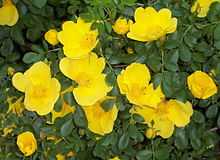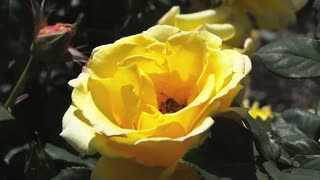Rosa foetida
| Rosa foetida | |
|---|---|
 | |
| Scientific classification | |
| Kingdom: | Plantae |
| (unranked): | Angiosperms |
| (unranked): | Eudicots |
| (unranked): | Rosids |
| Order: | Rosales |
| Family: | Rosaceae |
| Genus: | Rosa |
| Species: | R. foetida |
| Binomial name | |
| Rosa foetida Herrm. | |
| Synonyms[1] | |
| |
Rosa foetida, known by several common names, including Austrian briar,[2] Persian yellow rose,[2] and Austrian copper rose,[2] is a species of rose, native to the foothills of the Caucasus Mountains in Georgia. It has yellow flowers with a scent which some find objectionable. Since there were no yellow roses native to Europe, its introduction from Persia was an important addition to the cultivation of roses, and R. foetida is now an important contributor to the stock of cultivated roses.
Name
The rose is named for its smell--foetida is Latin for "having a bad smell"[3][4]—which is reminiscent of boiled linseed oil, a smell which some find objectionable.[5][6] However, according to others "the smell is not all that bad."[5]
Cultivation history
Rosa foetida was imported to Europe from Persia (R. foetida 'persiana' being the name of one of its varieties[7]), and was important to European horticulture since it had no native yellow roses. It was described (in 1583) and successfully cultivated by Carolus Clusius; he grew them in the imperial garden of Rudolf II in Vienna. Its popularity was aided by Clusius's contemporary, Flemish painter and engraver Joris Hoefnagel, who contrasted it with the Eglantine rose in a manuscript illustration.[8]
An important rose, inasmuch as it is the source of yellow in modern-day hybrids, most famously 'Soleil d'Or' (R. foetida x 'Antoine Ducher'; 1900), was bred by Joseph Pernet-Ducher. One variety, Rosa foetida var. 'bicolor' , the Austrian Copper rose, blooms early in the season and has flowers with petals that are red or orange on the upper interior surface but yellow on the lower exterior surface.[5] Rosa foetida has exerted great influence on the modern stock of cultivated roses,[9] contributing also its susceptibility to black spot.[7][10]
Description and cultivation

The rose is described as a "spindly bush, not terribly vigorous," requiring a stake or a wall, growing up to six feet tall.[6]
See also
- Rosa 'Harison's Yellow', a cultivar of Rosa foetida
- Rosa persica, not to be confused with Rosa foetida 'persiana'
References
- ↑ "The Plant List: A Working List of All Plant Species". Retrieved 28 December 2014.
- ↑ 2.0 2.1 2.2 "USDA GRIN Taxonomy".
- ↑ Parker, Carolyn (2005). R Is For Rose: Reflections From a Passionate Rose Lover. North Light Books. p. 49. ISBN 978-1-55870-759-7.
- ↑ Ellacombe, Henry Nicholson (1895). In a Gloucestershire garden. E. Arnold. p. 186.
- ↑ 5.0 5.1 5.2 Loewer, H. Peter (1999). Fragrant gardens: how to select and make the most of scented flowers and leaves. Houghton Mifflin Harcourt. p. 57. ISBN 978-0-395-88492-8.
- ↑ 6.0 6.1 Wolf, Rex; McNair, James K. (1995). All About Roses. Ortho Books. p. 10.
- ↑ 7.0 7.1 Forsyth, Holly Kerr (2007). The Constant Gardener: A Botanical Bible. The Miegunyah Press. pp. 150, 155. ISBN 978-0-522-85432-9.
- ↑ Fisher, Celia (2011). Flowers of the Renaissance. Francis Lincoln. p. 32. ISBN 978-0-7112-3068-2.
- ↑ Knapp, Sandra (2003). Plant discoveries: a botanist's voyage through plant exploration. Firefly Books. p. 172. ISBN 978-1-55297-810-8.
- ↑ Olson, Jerry; Whitman, John (1998). Growing roses in cold climates. Contemporary Books. pp. 74, 122. ISBN 978-0-8092-2941-3.